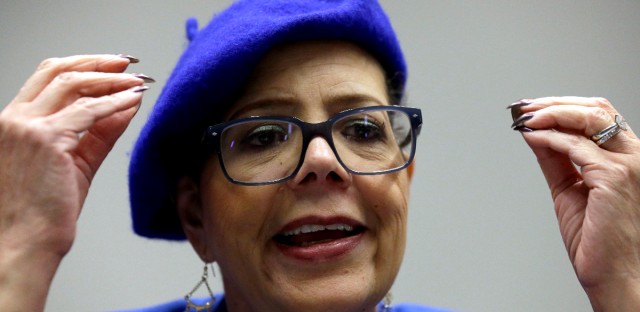Teachers Union, CPS Read Charter School Cap Differently

Chicago Teachers Union president Karen Lewis answers a question from media after a news conference on Wednesday, March 23, 2016.
Chicago Teachers Union officials have touted a provision in the newly approved teachers contract that limits the growth of controversial charter schools, saying it’s one of the biggest wins for union members.
But Chicago Public Schools officials said the cap does not necessarily mean there’s a district-wide moratorium on expanding charter schools.
“There’s plenty of room for high quality charter operators to apply and to go through our process,” said CPS CEO Forrest Claypool. “There is not a moratorium and there’s room under the cap for high quality charter operators.”
Charter schools are publicly funded, privately run schools that have long been criticized by the Chicago Teachers Union.
The new contract negotiated between CPS and the union states there will be no net increase in the number of charter schools approved by the Chicago Board of Education, the governing body overseeing CPS. The agreement also says the number of students enrolled at charter schools by the end of the 2018 to 2019 school year will not exceed 101 percent of the total number of students in charters during the 2015 to 2016 school year.
On the surface, this might sound like CPS won’t open any more charter schools or let charter schools add any students from now til the end of the contract.
But CPS officials have a different interpretation.
For one, Chicago teachers worked for a year without a contract, so the start of this contract is technically July 1, 2015.
At that time, CPS had 106 charter schools. Now it has 97. That means CPS could open nine charter schools and still keep its promise to the union.
The other key phrase in the side letter is “total student enrollment capacity.” This term has nothing to do with how many students can fit in a building, nor does it have anything to do with how many students actually are enrolled in a school.
Instead, enrollment capacity is a number negotiated by the charter operator and the school district, usually based on how many students the charter school thinks it can handle and how many students the district wants to send there.
So, for example, Legacy Charter School’s enrollment capacity is 554 students. This year, it has 470 students enrolled in a building that could accommodate 780 students.
All together, CPS officials said the enrollment capacity is 75,945.
Currently, charter enrollment is 52,877. This means CPS could let charters take in thousands of additional students.
Claypool said the school district will only open new charters where there is overcrowding or no quality option.
“This is prudent,” he said.
When asked about the district’s interpretation of the side letter, CTU President Karen Lewis noted that no other teachers union has gotten a school district to agree to such a provision.
What’s more, she says, charter schools don’t work.
“They are not doing a better job at a cheaper rate, which is what they promised,” she said.
Sarah Karp is an education reporter for WBEZ. You can follow her @SSKedreporter. Teachers Union, CPS Read Charter School Cap Differently | WBEZ:

